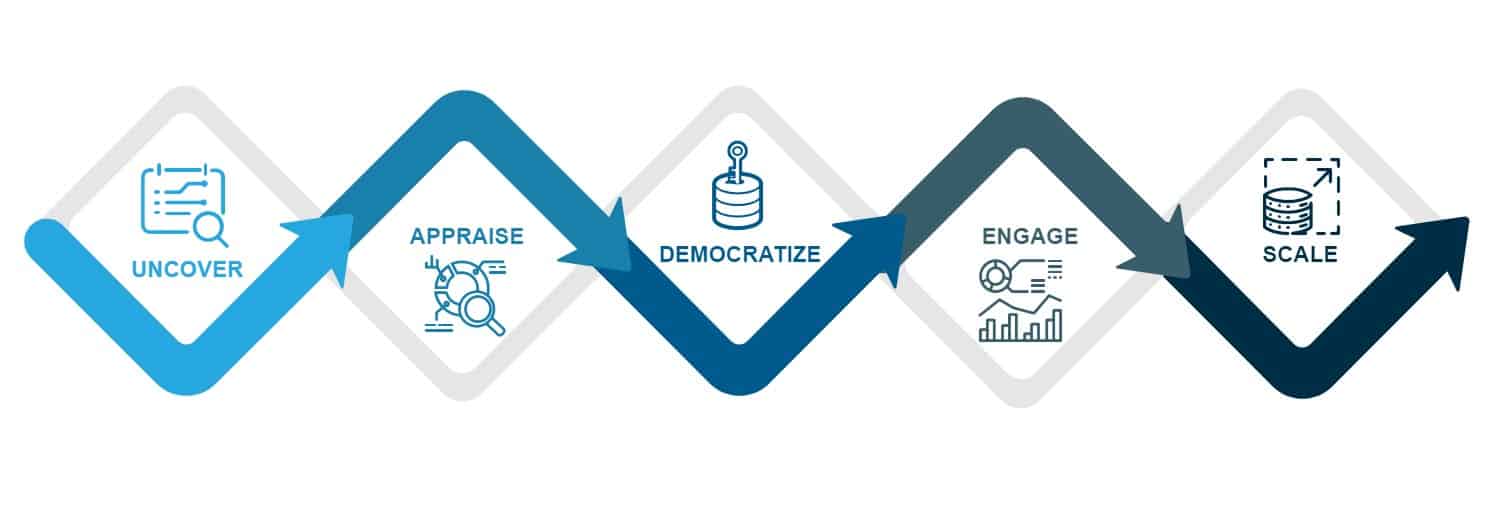Blog
A Five Step Framework for Data Literacy | Blog

In our first blog on data literacy, we highlighted the importance of moving from intuition-based to data-driven decision making and the benefits enterprises can accrue over time by establishing a data-first culture.
However, operationalizing data literacy within an organization is fraught with challenges that are rooted in legacy systems and people. So, we developed a framework that enterprises can embrace to embark on their journey towards becoming “data literate.”

Exhibit 1: Operationalizing data literacy
This framework helps enterprises uncover the value of data, democratize access to tools, and achieve scaled adoption of a data-driven culture across businesses and subfunctions. Here’s a quick look at the steps.
-
- UNCOVER: Enterprises should start with uncovering the datasets that will play a key role in decision making at various levels. This may include both internal and external data sets. While internal data will provide insights into the company’s business and day-to-day operations, external data or third-party data sets will provide added intelligence to deliver a holistic view of a given problem statement. For example, data collected through the company’s CRM platform, coupled with external data on a target audience across their digital avatars, will help the company better target/personalize their marketing communications across channels. To run this phase successfully, enterprises need to appoint data aggregators. Their key role will be to keep an account of the data that exists within the organization beyond the usual ERP systems. They will also focus on collating relevant data sets from external sources. This role will be supported by analytical systems running algorithms on historical data to find the best custom fit data source for standard decisions.
-
- APPRAISE: Uncovering data won’t yield benefits unless the data is appraised. Data appraisal has two aspects: data quality and access control. For business users to trust the data and the quality of data-based insights, enterprises need to ensure that the data is accurate, complete, consistent, reliable, and up to date. So, having the systems and processes in place for data quality management is key to enabling data literacy. For this, organizations will need to appoint data stewards who will be responsible for incorporating processes, policies, guidelines, and responsibilities for administering all of the organization’s data. They will need to be assisted by automated data quality and metadata management solutions. The future goal of any enterprise should be to equip all data owners with the right skills and tools to ensure data quality and policy upkeep.
-
- DEMOCRATIZE: Enterprises will only be able to glean value from their data if it’s in the right hands. They will need to identify the right stakeholders equipped with the right tools and skills who will be able to manipulate data to drive decisions. So, data democratization will be key to building a data-driven culture. However, governance and access control to ensure the right data reaches the right people will form a key pillar of this democratization. Here is where a data marketplace comes in. An enterprise-wide data marketplace will have external data sellers as well as the enterprise’s own data aggregators who will pour in the data through data stewards. Buyers will be the business users who will consume it to derive insights. A catalogued and secure marketplace within enterprises will become the most valuable asset.
- ENGAGE: Once the right dataset reaches the desired stakeholder, the stakeholder is responsible for deriving insights from it. So, enterprises must invest in developing data skills for the right set of business users. The development plan for business users should focus on two different aspects of training:
- Technical training focused on developing an understanding of data types (internal vs. external), data characteristics (formats, features), data applications (analytics, artificial intelligence, decision support), data techniques (pattern discovery, pattern recognition, prediction), etc.
- Non-technical training focused on training business users to “know, speak, and argue” with data by instilling data communication as a core part of their day-to-day activities.Enterprises should focus on upskilling their workforce through a robust learning program and investing in learning assets to promote ongoing development.
- SCALE: The first four steps are bound to reap benefits. But they may be short-lived unless organizations commit themselves to scaled adoption across functions and organizational levels. Companies will need to integrate the best practices that individuals who have achieved success use and create a conducive environment for others to follow suit. This may be achieved by developing and nurturing communities and forums within organizations to encourage data-driven decision making. It will also be important to identify specific data champions who would be the voice for change. These five steps, along with a data-first culture, will become the backbone of a data literate organization, promoting data literacy across the board to help transform into an intelligent enterprise. The change will need to be supported by a fit-for-purpose partner strategy to navigate the tools and technologies needed and the associated business, process, people, and technology change management.
If you have any questions about how data literacy can help your organization tackle complex situations, or if you would like to share how insights-driven decision making helped your organization work through a critical period, please write to us at [email protected] and [email protected].